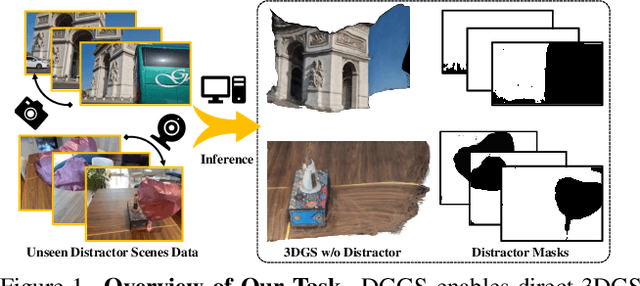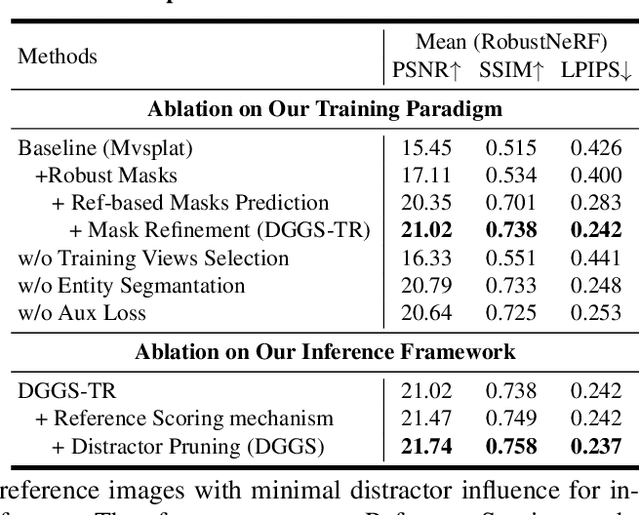Jing Huo
VITA-VLA: Efficiently Teaching Vision-Language Models to Act via Action Expert Distillation
Oct 10, 2025Abstract:Vision-Language Action (VLA) models significantly advance robotic manipulation by leveraging the strong perception capabilities of pretrained vision-language models (VLMs). By integrating action modules into these pretrained models, VLA methods exhibit improved generalization. However, training them from scratch is costly. In this work, we propose a simple yet effective distillation-based framework that equips VLMs with action-execution capability by transferring knowledge from pretrained small action models. Our architecture retains the original VLM structure, adding only an action token and a state encoder to incorporate physical inputs. To distill action knowledge, we adopt a two-stage training strategy. First, we perform lightweight alignment by mapping VLM hidden states into the action space of the small action model, enabling effective reuse of its pretrained action decoder and avoiding expensive pretraining. Second, we selectively fine-tune the language model, state encoder, and action modules, enabling the system to integrate multimodal inputs with precise action generation. Specifically, the action token provides the VLM with a direct handle for predicting future actions, while the state encoder allows the model to incorporate robot dynamics not captured by vision alone. This design yields substantial efficiency gains over training large VLA models from scratch. Compared with previous state-of-the-art methods, our method achieves 97.3% average success rate on LIBERO (11.8% improvement) and 93.5% on LIBERO-LONG (24.5% improvement). In real-world experiments across five manipulation tasks, our method consistently outperforms the teacher model, achieving 82.0% success rate (17% improvement), which demonstrate that action distillation effectively enables VLMs to generate precise actions while substantially reducing training costs.
MedSentry: Understanding and Mitigating Safety Risks in Medical LLM Multi-Agent Systems
May 27, 2025Abstract:As large language models (LLMs) are increasingly deployed in healthcare, ensuring their safety, particularly within collaborative multi-agent configurations, is paramount. In this paper we introduce MedSentry, a benchmark comprising 5 000 adversarial medical prompts spanning 25 threat categories with 100 subthemes. Coupled with this dataset, we develop an end-to-end attack-defense evaluation pipeline to systematically analyze how four representative multi-agent topologies (Layers, SharedPool, Centralized, and Decentralized) withstand attacks from 'dark-personality' agents. Our findings reveal critical differences in how these architectures handle information contamination and maintain robust decision-making, exposing their underlying vulnerability mechanisms. For instance, SharedPool's open information sharing makes it highly susceptible, whereas Decentralized architectures exhibit greater resilience thanks to inherent redundancy and isolation. To mitigate these risks, we propose a personality-scale detection and correction mechanism that identifies and rehabilitates malicious agents, restoring system safety to near-baseline levels. MedSentry thus furnishes both a rigorous evaluation framework and practical defense strategies that guide the design of safer LLM-based multi-agent systems in medical domains.
SEPT: Standard-Definition Map Enhanced Scene Perception and Topology Reasoning for Autonomous Driving
May 18, 2025Abstract:Online scene perception and topology reasoning are critical for autonomous vehicles to understand their driving environments, particularly for mapless driving systems that endeavor to reduce reliance on costly High-Definition (HD) maps. However, recent advances in online scene understanding still face limitations, especially in long-range or occluded scenarios, due to the inherent constraints of onboard sensors. To address this challenge, we propose a Standard-Definition (SD) Map Enhanced scene Perception and Topology reasoning (SEPT) framework, which explores how to effectively incorporate the SD map as prior knowledge into existing perception and reasoning pipelines. Specifically, we introduce a novel hybrid feature fusion strategy that combines SD maps with Bird's-Eye-View (BEV) features, considering both rasterized and vectorized representations, while mitigating potential misalignment between SD maps and BEV feature spaces. Additionally, we leverage the SD map characteristics to design an auxiliary intersection-aware keypoint detection task, which further enhances the overall scene understanding performance. Experimental results on the large-scale OpenLane-V2 dataset demonstrate that by effectively integrating SD map priors, our framework significantly improves both scene perception and topology reasoning, outperforming existing methods by a substantial margin.
DeCo: Task Decomposition and Skill Composition for Zero-Shot Generalization in Long-Horizon 3D Manipulation
May 01, 2025Abstract:Generalizing language-conditioned multi-task imitation learning (IL) models to novel long-horizon 3D manipulation tasks remains a significant challenge. To address this, we propose DeCo (Task Decomposition and Skill Composition), a model-agnostic framework compatible with various multi-task IL models, designed to enhance their zero-shot generalization to novel, compositional, long-horizon 3D manipulation tasks. DeCo first decomposes IL demonstrations into a set of modular atomic tasks based on the physical interaction between the gripper and objects, and constructs an atomic training dataset that enables models to learn a diverse set of reusable atomic skills during imitation learning. At inference time, DeCo leverages a vision-language model (VLM) to parse high-level instructions for novel long-horizon tasks, retrieve the relevant atomic skills, and dynamically schedule their execution; a spatially-aware skill-chaining module then ensures smooth, collision-free transitions between sequential skills. We evaluate DeCo in simulation using DeCoBench, a benchmark specifically designed to assess zero-shot generalization of multi-task IL models in compositional long-horizon 3D manipulation. Across three representative multi-task IL models (RVT-2, 3DDA, and ARP), DeCo achieves success rate improvements of 66.67%, 21.53%, and 57.92%, respectively, on 12 novel compositional tasks. Moreover, in real-world experiments, a DeCo-enhanced model trained on only 6 atomic tasks successfully completes 9 novel long-horizon tasks, yielding an average success rate improvement of 53.33% over the base multi-task IL model. Video demonstrations are available at: https://deco226.github.io.
Robust Dataset Distillation by Matching Adversarial Trajectories
Mar 15, 2025Abstract:Dataset distillation synthesizes compact datasets that enable models to achieve performance comparable to training on the original large-scale datasets. However, existing distillation methods overlook the robustness of the model, resulting in models that are vulnerable to adversarial attacks when trained on distilled data. To address this limitation, we introduce the task of ``robust dataset distillation", a novel paradigm that embeds adversarial robustness into the synthetic datasets during the distillation process. We propose Matching Adversarial Trajectories (MAT), a method that integrates adversarial training into trajectory-based dataset distillation. MAT incorporates adversarial samples during trajectory generation to obtain robust training trajectories, which are then used to guide the distillation process. As experimentally demonstrated, even through natural training on our distilled dataset, models can achieve enhanced adversarial robustness while maintaining competitive accuracy compared to existing distillation methods. Our work highlights robust dataset distillation as a new and important research direction and provides a strong baseline for future research to bridge the gap between efficient training and adversarial robustness.
RoboHorizon: An LLM-Assisted Multi-View World Model for Long-Horizon Robotic Manipulation
Jan 15, 2025



Abstract:Efficient control in long-horizon robotic manipulation is challenging due to complex representation and policy learning requirements. Model-based visual reinforcement learning (RL) has shown great potential in addressing these challenges but still faces notable limitations, particularly in handling sparse rewards and complex visual features in long-horizon environments. To address these limitations, we propose the Recognize-Sense-Plan-Act (RSPA) pipeline for long-horizon tasks and further introduce RoboHorizon, an LLM-assisted multi-view world model tailored for long-horizon robotic manipulation. In RoboHorizon, pre-trained LLMs generate dense reward structures for multi-stage sub-tasks based on task language instructions, enabling robots to better recognize long-horizon tasks. Keyframe discovery is then integrated into the multi-view masked autoencoder (MAE) architecture to enhance the robot's ability to sense critical task sequences, strengthening its multi-stage perception of long-horizon processes. Leveraging these dense rewards and multi-view representations, a robotic world model is constructed to efficiently plan long-horizon tasks, enabling the robot to reliably act through RL algorithms. Experiments on two representative benchmarks, RLBench and FurnitureBench, show that RoboHorizon outperforms state-of-the-art visual model-based RL methods, achieving a 23.35% improvement in task success rates on RLBench's 4 short-horizon tasks and a 29.23% improvement on 6 long-horizon tasks from RLBench and 3 furniture assembly tasks from FurnitureBench.
Distractor-free Generalizable 3D Gaussian Splatting
Nov 26, 2024



Abstract:We present DGGS, a novel framework addressing the previously unexplored challenge of Distractor-free Generalizable 3D Gaussian Splatting (3DGS). It accomplishes two key objectives: fortifying generalizable 3DGS against distractor-laden data during both training and inference phases, while successfully extending cross-scene adaptation capabilities to conventional distractor-free approaches. To achieve these objectives, DGGS introduces a scene-agnostic reference-based mask prediction and refinement methodology during training phase, coupled with a training view selection strategy, effectively improving distractor prediction accuracy and training stability. Moreover, to address distractor-induced voids and artifacts during inference stage, we propose a two-stage inference framework for better reference selection based on the predicted distractor masks, complemented by a distractor pruning module to eliminate residual distractor effects. Extensive generalization experiments demonstrate DGGS's advantages under distractor-laden conditions. Additionally, experimental results show that our scene-agnostic mask inference achieves accuracy comparable to scene-specific trained methods. Homepage is \url{https://github.com/bbbbby-99/DGGS}.
Magnetic Preference Optimization: Achieving Last-iterate Convergence for Language Models Alignment
Oct 22, 2024



Abstract:Self-play methods have demonstrated remarkable success in enhancing model capabilities across various domains. In the context of Reinforcement Learning from Human Feedback (RLHF), self-play not only boosts Large Language Model (LLM) performance but also overcomes the limitations of traditional Bradley-Terry (BT) model assumptions by finding the Nash equilibrium (NE) of a preference-based, two-player constant-sum game. However, existing methods either guarantee only average-iterate convergence, incurring high storage and inference costs, or converge to the NE of a regularized game, failing to accurately reflect true human preferences. In this paper, we introduce Magnetic Preference Optimization (MPO), a novel approach capable of achieving last-iterate convergence to the NE of the original game, effectively overcoming the limitations of existing methods. Building upon Magnetic Mirror Descent (MMD), MPO attains a linear convergence rate, making it particularly suitable for fine-tuning LLMs. To ensure our algorithm is both theoretically sound and practically viable, we present a simple yet effective implementation that adapts the theoretical insights to the RLHF setting. Empirical results demonstrate that MPO can significantly enhance the performance of LLMs, highlighting the potential of self-play methods in alignment.
GravMAD: Grounded Spatial Value Maps Guided Action Diffusion for Generalized 3D Manipulation
Sep 30, 2024Abstract:Robots' ability to follow language instructions and execute diverse 3D tasks is vital in robot learning. Traditional imitation learning-based methods perform well on seen tasks but struggle with novel, unseen ones due to variability. Recent approaches leverage large foundation models to assist in understanding novel tasks, thereby mitigating this issue. However, these methods lack a task-specific learning process, which is essential for an accurate understanding of 3D environments, often leading to execution failures. In this paper, we introduce GravMAD, a sub-goal-driven, language-conditioned action diffusion framework that combines the strengths of imitation learning and foundation models. Our approach breaks tasks into sub-goals based on language instructions, allowing auxiliary guidance during both training and inference. During training, we introduce Sub-goal Keypose Discovery to identify key sub-goals from demonstrations. Inference differs from training, as there are no demonstrations available, so we use pre-trained foundation models to bridge the gap and identify sub-goals for the current task. In both phases, GravMaps are generated from sub-goals, providing flexible 3D spatial guidance compared to fixed 3D positions. Empirical evaluations on RLBench show that GravMAD significantly outperforms state-of-the-art methods, with a 28.63% improvement on novel tasks and a 13.36% gain on tasks encountered during training. These results demonstrate GravMAD's strong multi-task learning and generalization in 3D manipulation. Video demonstrations are available at: https://gravmad.github.io.
3D Gaussian Splatting: Survey, Technologies, Challenges, and Opportunities
Jul 24, 2024



Abstract:3D Gaussian Splatting (3DGS) has emerged as a prominent technique with the potential to become a mainstream method for 3D representations. It can effectively transform multi-view images into explicit 3D Gaussian representations through efficient training, and achieve real-time rendering of novel views. This survey aims to analyze existing 3DGS-related works from multiple intersecting perspectives, including related tasks, technologies, challenges, and opportunities. The primary objective is to provide newcomers with a rapid understanding of the field and to assist researchers in methodically organizing existing technologies and challenges. Specifically, we delve into the optimization, application, and extension of 3DGS, categorizing them based on their focuses or motivations. Additionally, we summarize and classify nine types of technical modules and corresponding improvements identified in existing works. Based on these analyses, we further examine the common challenges and technologies across various tasks, proposing potential research opportunities.
 Add to Chrome
Add to Chrome Add to Firefox
Add to Firefox Add to Edge
Add to Edge